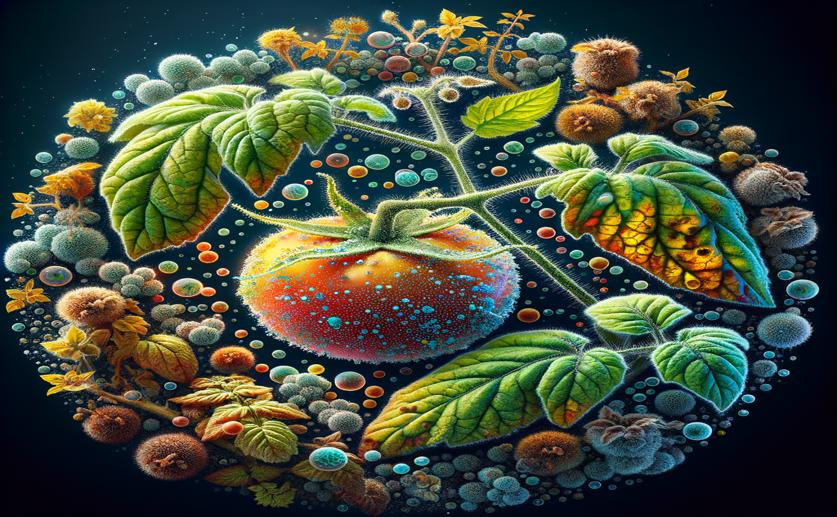Leaf Extract-Made Nanoparticles to Fight Tomato Blight

Image Source: Natural Science News, 2024
Key Findings
- In Pakistan, silver nanoparticles (Ag-NPs) were found to effectively combat tomato early blight, a fungal disease
- Ag-NPs were created using an eco-friendly method with Quercus incana leaf extract
- These nanoparticles stopped 98% of the fungus growth in lab tests, offering a sustainable alternative to chemical fungicides
Silver nanoparticles (Ag-NPs) have recently been spotlighted as a promising tool to combat various pathogens, including those resistant to traditional antibiotics. The latest research from the University of Poonch Rawalakot[1] has taken this concept into the agricultural domain, showcasing the potential of Ag-NPs to address a significant challenge in tomato farming: the fungal disease known as early blight (EB), caused by Alternaria solani.
EB is a common and destructive disease affecting tomatoes, characterized by dark, concentrically ringed lesions on leaves, stems, and fruits. This disease can lead to substantial crop losses and is traditionally managed using chemical fungicides. However, the overuse of these chemicals can disrupt environmental balance and contribute to the emergence of resistant fungal strains. Thus, the search for alternative, eco-friendly solutions is critical.
The study conducted by the University of Poonch Rawalakot offers a novel solution by utilizing Ag-NPs fabricated through a green synthesis process. This method employs leaf extract from the Quercus incana Roxb. tree, a species native to South Asia, as a reducing agent to convert silver ions into nanoparticles. This process not only avoids the use of hazardous chemicals but also promises a cost-effective approach to nanoparticle production.
Characterization of the synthesized Ag-NPs revealed that they were predominantly spherical with an average size of 27 nm. It is known from previous research that the size and shape of nanoparticles can significantly influence their antimicrobial properties[2]. In the case of Ag-NPs, smaller particles have been found to have enhanced bactericidal effects due to their larger surface area to volume ratio, which increases their interaction with microbial cells[2].
Testing the antifungal efficacy of these Ag-NPs against A. solani involved both in vitro Petri plate and in vitro leaflet assays. The results were striking, with a 100 mg/l concentration of Ag-NPs inhibiting fungal growth by 98.27 ± 1.58% and 92.79 ± 1.33%, respectively. These findings are in line with earlier studies that have demonstrated the microbial growth-inhibitory effects of Ag-NPs on various organisms, including bacteria and yeast[3].
The mechanism behind the antimicrobial action of Ag-NPs is attributed to several factors. It is believed that Ag-NPs can attach to and penetrate the cell walls of microorganisms, causing structural changes and leading to cell death. Additionally, the generation of reactive oxygen species (free radicals) by Ag-NPs can induce oxidative stress within microbial cells, further contributing to their inhibitory effects[3].
This study not only confirms the antifungal potential of Ag-NPs but also expands on previous research by applying this knowledge to a plant pathogen affecting a major agricultural crop[4]. The use of green-fabricated Ag-NPs presents an environmentally friendly alternative to conventional agrochemicals, with the added benefits of reduced chemical usage and potentially lower costs.
The success of this research suggests a new avenue for plant disease management, where nanotechnology can provide effective control measures against fungal pathogens. The practical application of green-fabricated Ag-NPs could revolutionize the way we protect crops like tomatoes from diseases such as EB, offering a sustainable and efficient solution to a problem that has long plagued farmers worldwide.
In conclusion, the integration of nanotechnology into agricultural practices, as demonstrated by the University of Poonch Rawalakot, points to a future where green synthesis of antimicrobial agents can play a crucial role in ensuring food security and environmental health. The findings of this study offer a promising step towards the adoption of nanomaterials in the fight against plant diseases, with the potential to significantly impact the field of agricultural biotechnology.
BiotechPlant ScienceAgriculture
References
Main Study
1) Green-fabricated silver nanoparticles from Quercus incana leaf extract to control the early blight of tomatoes caused by Alternaria solani.
Published 19th April, 2024
Journal: BMC plant biology
Issue: Vol 24, Issue 1, Apr 2024
Related Studies
3) Antimicrobial effects of silver nanoparticles.
Journal: Nanomedicine : nanotechnology, biology, and medicine, Issue: Vol 3, Issue 1, Mar 2007
Related Articles





 16th April, 2024 | Jenn Hoskins
16th April, 2024 | Jenn Hoskins